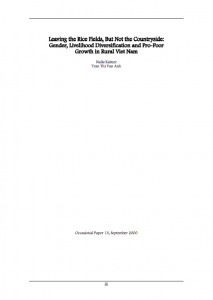‘Leaving the Rice Fields but not the Village’: Gender, livelihoods diversification and implications for pro-poor growth in rural Vietnam. UNRISD Discussion paper No. 13.
 In the late 1980s, Viet Nam initiated a programme of “economic renovation”, doi moi, to promote the transition from a centrally planned to a market-based economy. The key goals of the policy package were economic growth and social development, while the key means included decollectivization of agriculture, price liberalization, devaluation to achieve more realistic exchange rates, reduction of public sector employment and a concomitant promotion of private sector enterprise. The reforms were remarkably successful. Annual GDP growth rates rose, while poverty declined. Exports performed strongly, increasing at more than 30 per cent per annum after 1988. However, challenges remain. Rates of per capita growth are still low, as Viet Nam has a high ratio of labour relative to other factors of production, including physical capital, infrastructure, land and natural resources. The expansion of employment opportunities poses a major challenge for state policy. There is also concern that sections of the population have not benefited from the transition to the market economy, and that the pre-reform pattern of low rates of economic growth combined with “shared” poverty is being replaced by higher rates of growth but greater inequalities in income and opportunities.
In the late 1980s, Viet Nam initiated a programme of “economic renovation”, doi moi, to promote the transition from a centrally planned to a market-based economy. The key goals of the policy package were economic growth and social development, while the key means included decollectivization of agriculture, price liberalization, devaluation to achieve more realistic exchange rates, reduction of public sector employment and a concomitant promotion of private sector enterprise. The reforms were remarkably successful. Annual GDP growth rates rose, while poverty declined. Exports performed strongly, increasing at more than 30 per cent per annum after 1988. However, challenges remain. Rates of per capita growth are still low, as Viet Nam has a high ratio of labour relative to other factors of production, including physical capital, infrastructure, land and natural resources. The expansion of employment opportunities poses a major challenge for state policy. There is also concern that sections of the population have not benefited from the transition to the market economy, and that the pre-reform pattern of low rates of economic growth combined with “shared” poverty is being replaced by higher rates of growth but greater inequalities in income and opportunities.
[gview file=”http://www.unrisd.org/unrisd/website/document.nsf/ab82a6805797760f80256b4f005da1ab/9e3031cc9cb1c06380256b67005b75f3/$FILE/opb13.pdf”]



